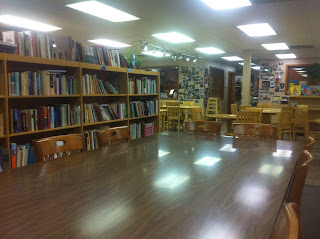
I'd like to begin with with a short apology for not posting in some time. No, I haven't been abducted or involved in a horrible car accident while traveling on the road--although I have logged quit a few miles since my last post. Instead, I spent some of the past week or so celebrating a birthday, driving, overcoming a case of influenza, and writing. But, I'm back.
This past weekend I had the great pleasure of attending the Myaamiaki Conference on Miami Tribe Scholarship at Miami University of Ohio. This year marked the fifth time that the Myaamia Project and the Miami Tribe of Oklahoma hosted the biennial event. The conference centered on the theme of Meeloniteeheelotaatiiyankwi, or “we reflect.” The theme marked several major milestones in the relationship between the Miami Tribe of Oklahoma and the university; the fortieth anniversary of an official relationship between the Miami Tribe of Oklahoma and Miami University, twenty years of Myaamia student scholarships (and the creation of the Myaamia Project in the academic year 1991-92), and ten years since the first Miaamiaki Conference. For me, it was my first attending the conference and meeting many of the people associated with the Myaamia Project.
The conference was a combination of scholarly presentations, informational presentations on the history of the Myaamia Project, and panel discussions with faculty and students who have contributed to the collaborative effort between the university and the Miami Tribe of Oklahoma. It ranged from complex linguistic analyses of Myaamia stories to the genetic relationships between Myaamia Miincipi (Miami White Corn) to the experience of current and former Myaamia students at Miami University of Ohio. As I sat through the day’s worth of presentations and panels, one thought crossed my mind—I knew less about Myaamia language and culture than I thought. As a scholar of early- and mid-nineteenth century Indiana history I’ve studied the complex history of commercial relationships between Miami chiefs and Anglo-traders; but in the larger picture of what I witnessed on Saturday, that was only a tiny fraction of the story. Interestingly, I realized that the less I knew and the more uncomfortable I felt as an “expert” on the subject, the more encouraged I felt as a responsible and culturally sensitive scholar.
I also took the opportunity this weekend to embrace the conference theme of “reflect.” I was impressed by the mutually beneficial relationship that has been forged between the Miami Tribe of Oklahoma and Miami University of Ohio. The university hosts an office specifically dedicated to the Myaamia Project and tribal relations. Faculty members develop courses that take students to Indian Country and work with the Miami Nation. (Perhaps the most fascinating presentation centered on a computer science course that developed an iPhone application that scans barcodes that are placed around the home. Those barcodes link to an audio file that voices the item in the Myaamia language.) These forms of service learning, dedicated to aiding the Myaamia community, make me want to return home and do something.
My home institution, Oklahoma City University, sponsors an American Indian Scholarship program—offering free tuition, basic room and board, and book stipend to about 25 qualified students each academic year (if you know a young Native student who would like a free education, please pass that information and link along). Student scholars have been proactive in organizing their own activates, student organization, and community on campus, but they lack the type of institutional support that appears on the Miami University campus. More importantly, Oklahoma City University (located in the heart of Indian Country) represents an older paternalistic approach to educating American Indian youth that the Miami Tribe of Oklahoma and the Miami University have seemingly overcome. The OCU AIS webpage states, “Not only is this opportunity incredible for students of American Indian descent, it is exciting for Oklahoma City University as we build on our history and commitment to serving Oklahoma.” But are Oklahomans really what the scholarships are about? What about serving the interests of sovereign tribes or nations and their community members? Shouldn’t that be the objective? Shouldn’t we be reaching out to the communities to identify those needs?
Moreover, Oklahoma City University houses a Native American Legal Resource Center within its Law School. Its mission statement--“to utilize knowledge and resources to serve the needs of Indian Country in a culturally appropriate and efficient manner for a maximum positive impact”—more closely resembles the relationship between the Miami Tribe of Oklahoma and Miami University, but it’s sequestered within the Law School—at OCU rarely do the paths of undergraduates and law students cross, except perhaps at Alvins’ Café as they fight for cups of coffee in the morning. Hopefully, this will not always be the case.
This weekend has inspired me to return to OCU and push administrators and faculty to rethink the relationship between our philanthropic (and perhaps paternalistic) scholarship program and the larger objective of aiding Native communities in Oklahoma. While my time on the road has saved me from the incessant state-sponsored commercials on Oklahoman television that reject the water rights of sovereign nations, I have not forgot that OCU could be a place where Native community members gain legal expertise that could be used to defend communities against the ever-encroaching interests of Oklahomans and Oklahoma City.
In all, I left the weekend exhausted, enlightened, and encouraged. I can only hope to gain the willpower and commitment to see some of reflections reach fruition. Ultimately, I hope that you (as a reader and witness) will hold me to it. Until next time.....

 It’s clear that William Hale was interested in preserving local indigenous history, but it’s less clear about what he thought that history comprised. How can I explain his use of plains-
It’s clear that William Hale was interested in preserving local indigenous history, but it’s less clear about what he thought that history comprised. How can I explain his use of plains-





